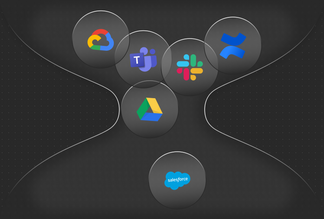

Speaking truth to the myth of nonverbal communication
The cleanest argument for returning to an office-first culture of synchronous and spontaneous interaction is so simple, so sensible, that a handful of executives have recently regurgitated it with signature C-suite conviction: “93% of communication is nonverbal; that’s how much value we lose when we can’t interact in-person.”
If this is your leader, please come get them. They’re drunk on one of the biggest myths in social psychology.
We’re going to break down the fallacy of the “93% nonverbal communication” rule in two acts: why the number is completely irrelevant to the workplace, and why healthy businesses spend significant resources to reduce whatever the actual number is.
Nope, 93% of communication is not nonverbal
First, let’s get on the same page about “nonverbal communication:” the spoken word is obviously verbal, but for business purposes, written communication as a proxy for speech would also be considered verbal. So, nonverbal communication encompasses:
- gestures, posture, and body movement
- facial expressions and eye contact
- pitch, tone, and timing of words
- touch and other senses
- “proxemics” (i.e., how people use personal space to influence communication)
The popular 93% figure originated from a mashing together of two studies conducted by UCLA professor Albert Mehrabian, and you’ll be surprised to learn just how irrelevant those studies are to this rule we’ve since internalized as a standard of human interaction:
In both studies, lab participants were asked to hear singular words several times (the word in the first study was “maybe”), and then approximate the speaker’s underlying emotional state behind each spoken word. Study #1 analyzed how facial expressions impacted the perception of the emotion, and Study #2 analyzed how tone impacted it.
That’s it. That’s the research.
Neither of the studies analyzed complete sentences, let alone full speeches or conversations. None of the other nonverbal communication variables were analyzed. In fact, the studies didn’t even focus on gleaning anything beyond a rudimentary perception of “like vs. dislike.” In other words, the studies basically created an artificial environment with a 1:1 ratio of words spoken to emotions interpreted. Nobody functions that way in reality.
Mehrabian himself has since cautioned against taking his research seriously outside of its context, stating, “unless a communicator is talking about their feelings or attitudes, these equations are not applicable.”
It goes without saying — no pun intended — that your workplace churns out a far more lopsided ratio of explicit-to-implicit communication. Messages, meetings, documents, presentations … these comms are not only brimming with far more complex words and environments than Mehrabian’s studies, but also weighted much more toward objective information like priorities, facts and figures, processes, and schedules. There is simply no significant correlation between the precarious lab findings at UCLA and the constant barrage of complex interactions we experience at work.
Now that we’ve dispelled the myth of nonverbal communication, let’s squash any semblance of its primitive appeal so leaders can stop fantasizing about the way communication works, and start investing in the platforms that actually enable productive communication.
Nonverbal communication is bad for business
We mentioned the “primitive appeal” of the 93% number — what is that, exactly?
For many, and especially for Type A business leaders, it’s the exciting notion that you might be able to gain an advantage or otherwise benefit from gathering secret information that wasn’t explicitly communicated. It’s the allure of reading “between the lines” to reach the underlying intent (which, to be clear, is not actually correlated to nonverbal communication in that intent can easily be misinterpreted through non-communication or manipulative communication. Just ask the people who study polygraph tests).
Perhaps it comes from our prehistoric interactions with potential predators or mates; who knows? Regardless, it’s primitive, and that’s why it’s so detrimental to the civilized social structure of a business.
Your coworkers are not threatening predators. They are a curated, incentivized, and managed group of people who share your goals, and whose trust is supposed to be inherent. It shouldn’t be your obligation to interpret whether a coworker means you ill intent or is hiding something — the confines of your organization should be, by design, a safe space to cooperate and collaborate transparently.
Ironically, the distinction between explicit communication and “secret” information is one of the core arguments in favor of building a remote-first organization, rather than an office-dependent one:
- It’s neither productive nor equitable to have a meeting presenter’s information interpreted uniquely by each coworker based on how sharp their nonverbal listening skills are. Everyone should walk out of the meeting with the same knowledge, and documenting it mitigates much of the subjectivity introduced by nonverbal communication.
- Managers who give arcane direction and prioritization will often use the crutch of nonverbal communication to escape accountability, continuing to drag down morale and productivity across the org. Barking at employees, leaning over their desks, showing facial expressions of anger or disappointment when challenged … all of this is done to push their own agendas through the paths of least resistance (i.e., the most easily intimidated employees) rather than be held accountable to any shared task management system or priority list where conflicting work exists.
- Many employees lack a natural skill set for presentation and persuasion. Of course, that doesn’t mean the employees don’t have ideas worth listening to. In an office environment, a junior engineer might sit slumped in their chair, looking at their hands while mumbling an objection to leadership’s approach — as a result, their warning falls on deaf ears. In a work hub-enabled environment, they can take the opportunity to present their opinion more convincingly, even with linked material supporting the case, and have that comment stand equally among the rest of their teammates’ perspectives.
An environment where coworkers don’t feel empowered to communicate transparently, or where leaders take advantage to avoid transparency, is simply a toxic environment. Investing in a centralized digital working space like a work hub isn’t just good for operational productivity — it’s medicine for a diseased culture eating away at its own trust and alignment. Nonverbal communication is certainly a part of human interaction, but it’s not what we want in the workplace.


